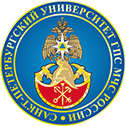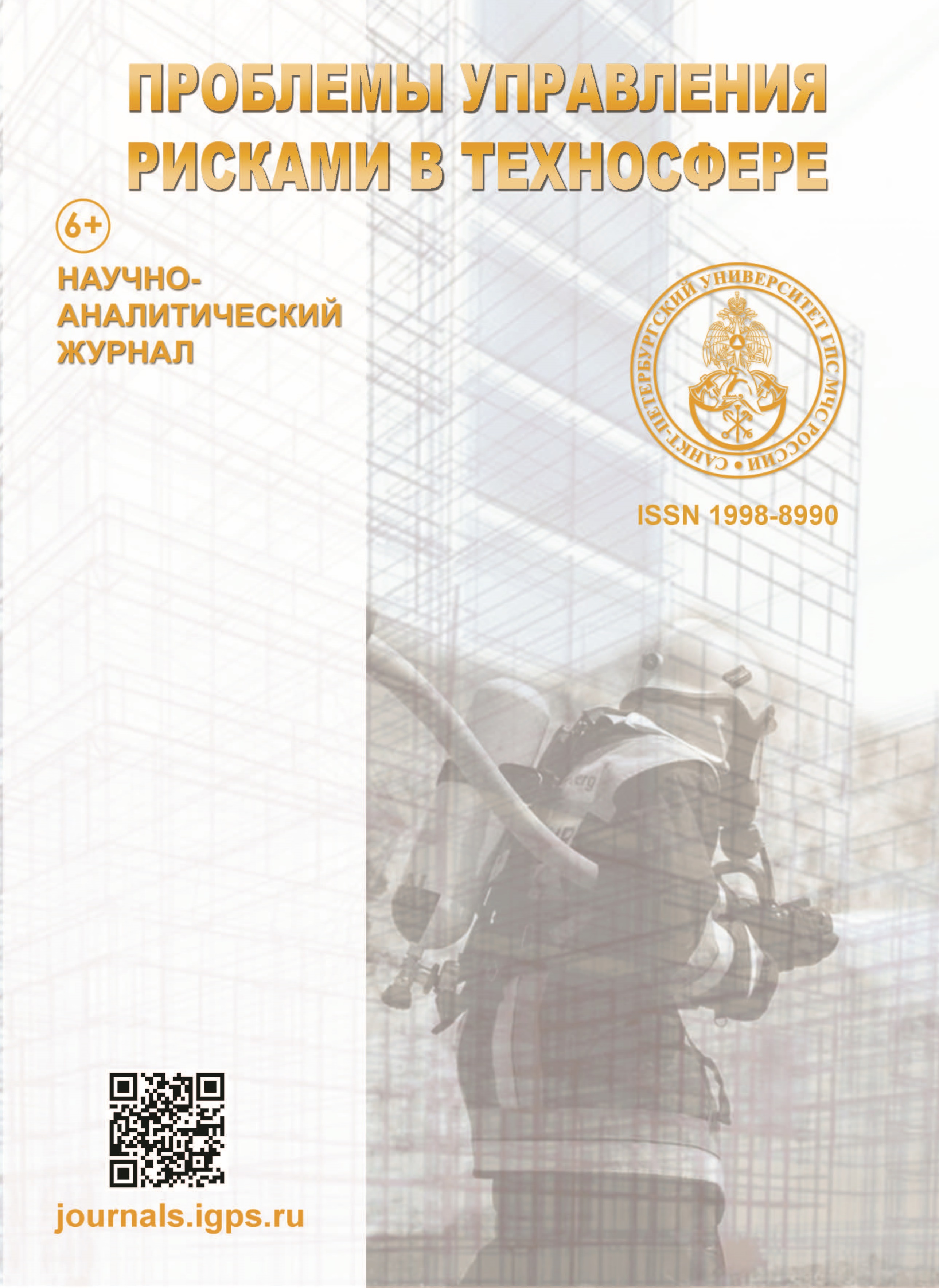Russian Federation
Institute of information technologies MIREA – Russian technological university (department of applied mathematics, professor)
Russian Federation
Russian Federation
Modeling emergency situations during the design phase of a protected object should occur in the absence of established design standards and the formulation of specific technical conditions. The generation of these solutions necessitates a comprehensive analysis of the protected object and a high level of expertise in fire safety matters. It is recommended that territorial regulatory and technical councils collaborate with specialists from specialized educational and research institutions affiliated with EMERCOM of Russia when evaluating special technical conditions. This collaboration may involve including these specialists in the commission or producing a separate report on a contractual basis. The study highlights the intricacies of modeling maximum heat flux density during a fire and developing compensatory measures, incorporating feedback from experts at a fire-technical educational institution. A shopping center, for which no design standards for selecting fire barriers exist, is used as a case study. Seven potential emergency scenarios are analyzed, and typical observations are identified during these assessments. Developers are urged to prioritize the calculation of fire risk and to consider the evacuation time of individuals as a critical factor in their designs.
emergency situations, special technical conditions, fire simulation, maximum heat flux density, fire risk
1. Novye sredstva obespecheniya evakuacii v obshchestvennyh zdaniyah s massovym prebyvaniem lyudej / V.D. Zahmatov [i dr.] // Pozharovzryvobezopasnost'. 2018. T. 27. № 5. S. 61–69.
2. Issledovanie osobennostej processa evakuacii dlya ob"ektov kul'turnogo naslediya / T.Yu. Eremina [i dr.] // Pozharovzryvobezopasnost'. 2019. T. 28. № 1. S. 54–66.
3. Panov A.A., Zhuravlev S.Yu., Zhuravlev Yu.Yu. Nezavisimaya ocenka riska i iskhodnye dannye dlya rascheta pozharnogo riska v obshchestvennyh zdaniyah, sooruzheniyah i pozharnyh otsekah razlichnyh klassov funkcional'noj pozharnoj opasnosti / A.A. Panov // Pozharovzryvobezopasnost'. 2019. T. 28. № 5. S. 9–18. DOI:https://doi.org/10.18322/PVB.2019.28.05.9-18.
4. Russkih D.V., Vytovtov A.V., Shevcov S.A. Osobennosti processa evakuacii lyudej iz proizvodstvennogo pomeshcheniya pri pozhare // Tekhnosfernaya bezopasnost'. 2019. № 1 (22). S. 70–82.
5. Miron'chev A.V., Tursenev S.A. Metody tekhnicheskogo regulirovaniya pozharnoj bezopasnosti ob"ektov kapital'nogo stroitel'stva // Pozharnaya bezopasnost' obshchestvennyh i zhilyh zdanij. Normativy, proektirovanie, ustrojstvo i ekspluataciya: materialynauch.-tekhn. konf. 2018. S. 5–8.
6. Study of children evacuation from pre-school education institutions / V.V. Kholshchevnikov [et al.] // Fire and Materials. 2012. Vol. 36. № 5–6. P. 349–366.
7. Kodur V.K.R., Venkatachari S.N., Egress M.Z. Parameters Influencing Emergency Evacuation in High-Rise Buildings // Fire Technol. 2020. Vol. 56. P. 2035–2057. DOI:https://doi.org/10.1007/s10694-020-00965-3.
8. Minkin D.Yu., Miron'chev A.V., Kondrashin A.V. Perspektivy razvitiya tekhnicheskogo regulirovaniya protivodymnoj zashchity zdanij // Problemy upravleniya riskami v tekhnosfere. 2015. № 3 (35). S. 23–28.
9. Miron'chev A.V., Tursenev S.A. Ranzhirovanie trebovanij tekhnicheskogo regulirovaniya pozharnoj bezopasnosti // Pozharnaya bezopasnost' ob"ektov kapital'nogo stroitel'stva. Normativy, proektirovanie, ustrojstvo i ekspluataciya: materialy nauch.-tekhn. konf. SPb., 2021. S. 5–8.
10. Analiticheskij obzor opyta razrabotki special'nyh tekhnicheskih uslovij pri proektirovanii zdanij obshchestvennogo naznacheniya / A.V. Golkin [i dr.] // Aktual'nye voprosy pozharnoj bezopasnosti. 2023. № 3 (17). S. 37–43.
11. Piunov V.V., Shternov V.P. Analiz strategicheskih nacional'nyh prioritetov v strategii nacional'noj bezopasnosti // Nauchnye i obrazovatel'nye problemy grazhdanskoj zashchity. 2022. № 1 (52). S. 18–26.
12. Deere S. An evacuation model validation data-set for high-rise construction sites // Fire Safety Journal. 2021. Vol. 120. P. 103118.
13. Monitoring of technogenic destructions of oil and gas facilities using 3D laser scanning / O.A. Gubanova [et al.] // International Journal of Engineering and Technology (UAE). 2018. Vol. 7. Iss. 4. P. 210–212.
14. Ramli N., Ghani N.A., Ahmad N. Psychological Response in Fire: A Fuzzy Bayesian Network Approach Using Expert Judgment // Fire Technol. 2021. Vol. 57. P. 2305–2338. DOI:https://doi.org/10.1007/s10694-021-01106-0.
15. Gilbert S.W. Estimating Smoke Alarm Effectiveness in Homes // Fire Technol. 2021. Vol. 57. P. 1497–1516. DOI:https://doi.org/10.1007/s10694-020-01072-z.
16. Loskutov N.V., Miron'chev A.V., Chizhkov A.G. Osushchestvlenie gosudarstvennogo kontrolya za sistemami pozharnoj signalizacii v usloviyah primeneniya mekhanizma «regulyatornoj gil'otiny» // Problemy upravleniya riskami v tekhnosfere. 2021. № 1 (57). S. 59–68.
17. Forssberg M., Kjellström J., Frantzich H. The Variation of Pre-movement Time in Building Evacuation // Fire Technol. 2019. Vol. 55. P. 2491–2513.
18. Loskutov N.V., Miron'chev A.V. Sozdanie sistem pozharnoj signalizacii v sovremennyh usloviyah tekhnicheskogo regulirovaniya // Pozharnaya bezopasnost' ob"ektov kapital'nogo stroitel'stva. Normativy, proektirovanie, ustrojstvo i ekspluataciya: materialy nauch.-tekhn. konf. SPb., 2021. S. 102–106.
19. Bode N.W.F., Codling E.A. Exploring Determinants of Pre-movement Delays in a Virtual Crowd Evacuation Experiment // Fire Technol. 2019. Vol. 55. P. 595–615.
20. Prognozirovanie osnovnyh pokazatelej pozharovzryvoopasnosti organicheskih soedinenij s pomoshch'yu deskriptorov i iskusstvennyh nejronnyh setej, ispol'zuemyh v raschete pozharnogo riska / D.S. Korolev [i dr.] // Pozharovzryvobezopasnost'. 2015. T. 24. № 9. S. 32–38.
21. Ronchi E. Developing and validating evacuation models for fire safety engineering // Fire Safety Journal. 2021. Vol. 120. P. 103020. DOI:https://doi.org/10.1016/j.firesaf.2020.103020.
22. Chu M.L., Law K.H. Incorporating Individual Behavior, Knowledge, and Roles in Simulating Evacuation // Fire Technol. 2019. P. 55.







